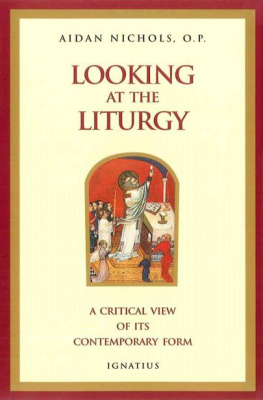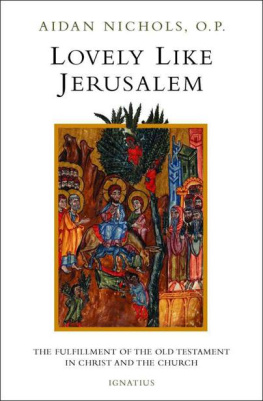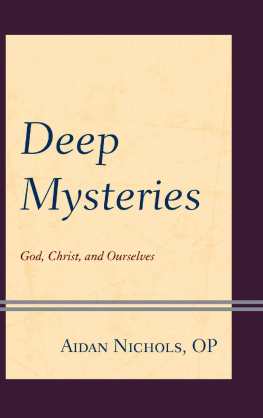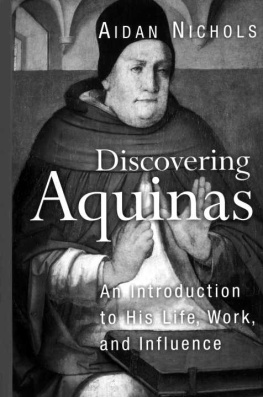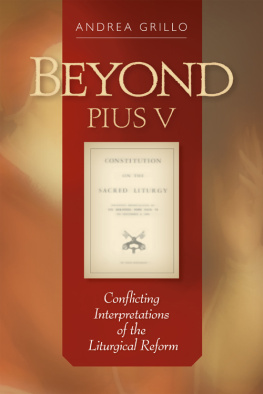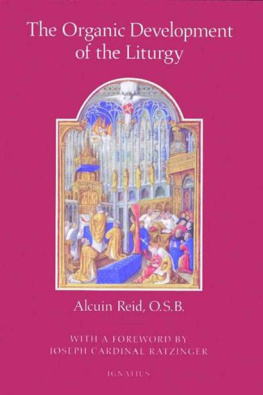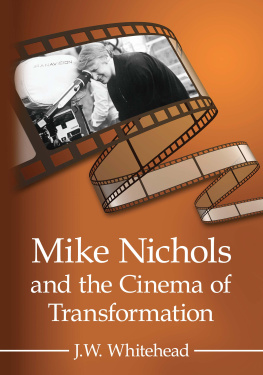Aidan Nichols - Looking At The Liturgy: A Critical View Of Its Contemporary Form
Here you can read online Aidan Nichols - Looking At The Liturgy: A Critical View Of Its Contemporary Form full text of the book (entire story) in english for free. Download pdf and epub, get meaning, cover and reviews about this ebook. year: 2011, genre: Religion. Description of the work, (preface) as well as reviews are available. Best literature library LitArk.com created for fans of good reading and offers a wide selection of genres:
Romance novel
Science fiction
Adventure
Detective
Science
History
Home and family
Prose
Art
Politics
Computer
Non-fiction
Religion
Business
Children
Humor
Choose a favorite category and find really read worthwhile books. Enjoy immersion in the world of imagination, feel the emotions of the characters or learn something new for yourself, make an fascinating discovery.
- Book:Looking At The Liturgy: A Critical View Of Its Contemporary Form
- Author:
- Genre:
- Year:2011
- Rating:3 / 5
- Favourites:Add to favourites
- Your mark:
- 60
- 1
- 2
- 3
- 4
- 5
Looking At The Liturgy: A Critical View Of Its Contemporary Form: summary, description and annotation
We offer to read an annotation, description, summary or preface (depends on what the author of the book "Looking At The Liturgy: A Critical View Of Its Contemporary Form" wrote himself). If you haven't found the necessary information about the book — write in the comments, we will try to find it.
Looking At The Liturgy: A Critical View Of Its Contemporary Form — read online for free the complete book (whole text) full work
Below is the text of the book, divided by pages. System saving the place of the last page read, allows you to conveniently read the book "Looking At The Liturgy: A Critical View Of Its Contemporary Form" online for free, without having to search again every time where you left off. Put a bookmark, and you can go to the page where you finished reading at any time.
Font size:
Interval:
Bookmark:
LOOKING AT THE LITURGY
AIDAN NICHOLS, O.P.
THE LITURGY
A Critical View of Its Contemporary Form
IGNATIUS PRESS SAN FRANCISCO
Cover art: Illumination from
a 14th century missal
Cover design by Roxanne Mei Lum
1996 Ignatius Press
All rights reserved
With ecclesiastical approval
ISBN 0-89870-592-4
Library of Congress catalogue number 96-83645
Printed in the United States of America
-Owen Chadwick, The Reformation
CONTENTS
PREFACE
There can hardly be a more important topic than the Liturgy if it really is, as the Fathers of the Second Vatican Council maintained, the source from which the Churchs life flows and the summit to which that life is directed. Liturgy, evidently, is too important to be left to liturgists. Not only the official liturgical advisers of the bishops but also all those to whom the celebration of the Liturgy is entrustedand this must in practice mean first and foremost the presbyterate as well as all those for whom the celebration is carried out, the lay faithfulhave a right and a duty to be concerned about what happens to the Liturgy of the Church.
Liturgy is too important to be left to liturgists. This dictum could also be interpreted as directing our attention to the help that theologians and historians, anthropologists and sociologists, and students of architecture and the other visual arts, of music, and of language might have to contribute to this topic. And in point of fact, in the course of this study I shall be looking in turn at what, in the first place, historians can teach us about the recent reform of the Roman rite; at what, secondly, anthropologists can tell us; and, finally, at what, in an omnium-gatherum term, we may call cultural critics can do to enlighten us on this vital subject.
I am grateful to Father Geoffrey Jarrett, president of the Australian Confraternity of Catholic Clergy, for inviting me to give the lectures on which this book is based (at Melbourne, in August 1995) and to my friend Dr. William Tighe of the University of Allentown, Pennsylvania, for supplying me with relevant materials. I regard this small book as a modest contribution to that debate on the desirability of the reform of the reform that Cardinal Joseph Ratzinger has called for in the wake of a widely felt dissatisfaction with the present liturgical life of the Latin ritual church in Catholicism today.
Blackfriars,
Cambridge, 1995
Nativity of the Blessed Virgin Mary
I
A HISTORICAL INQUEST
In this chapter I propose a perspective on the recent liturgical reform and, notably, on the antecedents and character of the Liturgical Movement that forms its essential background and inspiration.
All historical research and interpretation bear some relation to detective enquiry, but as this is not a detective thriller, I feel no compunction about offering my conclusion at the start. Not enough attention was paid to certain ambiguities in the history of the liturgical movement either by those who brought about the Second Vatican Councils commitment to the liturgical renewal, in the Constitution Sacrosanctum concilium , or by those who subsequently worked to give that commitment concrete form in the revised liturgical books whose publication began with the issue of the reformed Roman Calendar in 1969. As a result, the creation of the new Missal and Liturgy of the Hours, as well as the variety of ordines that correspond to the Pontificate Romanum (for the use of bishops) and the Situate Romanum (for the use of priests and other ministers), was unfortunately attended by infelicities that to some degree provided the occasion for the liturgical abuses that have been so sorry an aspect of Western Catholicism in the last thirty years.
The question obviously arises: What do I mean by certain ambiguities in the history of the liturgical movement, which, had people been more aware of them, might well have been better handled, leaving us today with happier results? Histories of the liturgical movement are not entirely agreed on the date of the movements inception. Dom Bernard Botte, monk of Mont Csar (Louvain) and one of the principal authors of the revised Liturgy, in his delightful autobiography Le Mouvement liturgique: Tmoignage et souvenirs , plumps for the Malines Congress of 1909, when his confrere Dom Lambert Beauduin presented a celebrated paper on the participation of the faithful, in Christian worship. A counterpart who, as his memoirs make clear, was most decidedly a Walloon and quite self-consciously not a Frenchman insists that the movement both began in Belgium and was begun by a Belgian. There is, however, more to it than that. For an author like Botte, to whom practical revision of the external form of the Liturgy was exceedingly important and in whose eyes the decisive epoch of the liturgical movement was, therefore, what we may call its political phase, when it set out to be a force on the stage of the world Church from 1945 onward, Beauduins manifesto of popular active participation in the liturgical rite totally overshadowed mere attempts to understand and draw a spirituality from the existing Liturgy, which was what the nineteenth century excelled in.
However questionable Bottes decision to date the liturgical movement from that precise year (1909) may be, his presentation has proved influential, and not simply among his conationals. Thus Dom Burchard Neunheuser, monk of Maria Laach, in a major retrospective on the postconciliar liturgical reform published in the 1978 Archiv fur Liturgiewissenschaft , At Malines, so the suggestion seems to run, all earlier types and foreshadowings were fulfilled, and liturgical salvation was at last thrown open to all succeeding ages.
Earlier German commentators, when touching on the origins of the movement, were less inclined to hand the palm to the Latin races. Thus Dom Damasus Winzen located the beginnings in the first Liturgical Week held for laypeople at Neunheusers own abbey, Maria Laach, in Holy Week 1914.
I am not sure whether Botte and Neunheuser were unaware of, or, as seems more likely, chose simply to ignore, what is by far the best researched and most comprehensive study of the genesis of our subject. Waldemar Trapps Vorgeschichte und Ursprung der liturgischen Bewegung , though (as its author admits in a subtitle) principally concerned with the German-speaking lands, also looks around at what was happening in the rest of Europe as well. This book, published at Regensburg during wartime conditions in 1940, was difficult of access to later scholars until its republication by photostatic repropublished as it was at Regensburg during wartime conditions in 1940, was difficult of access to later scholars until its republication by photostatic reproduction at Minister in 1979. It is an extremely illuminating document.
First of all, Trapps study makes it abundantly clear that the origins of the liturgical movement lie in the eighteenth century Enlightenment. In Germany and Austria above all, but to some extent in north-central Italy and France as well, the Enlightenment had known a specifically Catholic incarnation, though not always of a well-balanced sort. Trapp distinguished between what he calls the extreme Enlightenment, where a secular Weltanschauung imposed its own laws of thinking on ecclesial life, and a moderate Enlightenment more acceptable to Christian orthodoxy where Churchmen used, rather than were used by, certain aspects of the spirit of the age for the better setting forth of the Gospel. But he nonetheless found in the two taken together (and discerning the borderline between them is not always easy) some elements closely approximating to certain constituent features of the liturgical movement as he himself knew it in the Bavaria of the 1930sand some others that were, rather, what he terms counterpositions. Those latter elements, which Trapp and other Catholic exponents of the pre-1945 liturgical movementfor example, Romano Guardiniabjured, may be rather more familiar to us in the worldwide Latin ritual church of the 1990s. But both those features of the Enlightenment-period liturgical movement that Trapp defended and those that he spurned will repay reflection.
Next pageFont size:
Interval:
Bookmark:
Similar books «Looking At The Liturgy: A Critical View Of Its Contemporary Form»
Look at similar books to Looking At The Liturgy: A Critical View Of Its Contemporary Form. We have selected literature similar in name and meaning in the hope of providing readers with more options to find new, interesting, not yet read works.
Discussion, reviews of the book Looking At The Liturgy: A Critical View Of Its Contemporary Form and just readers' own opinions. Leave your comments, write what you think about the work, its meaning or the main characters. Specify what exactly you liked and what you didn't like, and why you think so.

